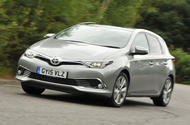
The Toyota Auris is super-rational and a good ownership proposition, but it lacks character and dynamics of the best in class
“A deeply rational, unemotional choice”: Autocar’s road test of the Toyota Auris hit the nail on the head.It is exactly that, and it’s a justifiable criticism of the model as a new car, but as a used one it’s a compliment. After all, who, faced with a sea of questionable, second-hand motors, wouldn’t prioritise being rational over emotional?True, you can be both and still come out on top, but for the rest of us, haunted by past indiscretions, a used, second-generation Auris looks like a safe haven.It was launched in 2013 in five-door hatch and Touring Sports estate forms. Toyota said the Volkswagen Golf Mk6 had been its benchmark when designing the new models. They’re certainly proving to be just as durable but otherwise the old Golf aces them on just about every measure bar perhaps the Auris’s hybrid technology.The 134bhp 1.8-litre VVT-h engine can do a claimed 70mpg, although expect closer to 50mpg, and a little over one mile on battery power alone.It’s a technical marvel paired with a clever automatic gearbox that enables the system to transition between power sources, or even combine them, and ensures the engine runs at its most efficient revs. The result is a quiet, smooth and relaxing drive, albeit one lacking in verve.The VVT-h was certainly a popular choice such that today almost two-thirds of the hatchbacks and nearly all of the Touring Sports advertised for sale are this version.The remaining engines include a handful of petrols, easily the best being the smooth and gutsy 114bhp 1.2T, introduced in 2015. The two diesels, an 89bhp 1.4 D-4D and a 109bhp 1.6D, are less impressive: they’re sluggish and rattly. In Euro 6 guise, they’re particularly thin on the ground too.Surprisingly, fewer Touring Sports than hatchbacks are diesels. Lesser-powered Auris models run a fairly basic suspension set-up but the 1.2T, 1.6 V-Matic, 1.8 VVT-h and 1.6D benefit from a more sophisticated arrangement that brings a smoother ride and, at least in Auris terms, keener handling.The model was facelifted in 2015, when it gained new headlights, LED tail-lights and grille and revised bumpers, all of them giving the car a more purposeful appearance. The interior was upgraded too. (Earlier models look a little drab and some plastics feel cheap.)Despite its low and sleek profile, the Auris is reasonably roomy and offers a good driving position. The hatchback’s boot is 350 litres with the seats up and 1200 litres folded (more than the then Ford Focus), compared with the Touring Sports’ 530 litres and 1658 litres respectively.Trim levels range from Active to Excel. Mid-level Icon and plush Excel are the most popular. Icon has 16in alloys, 7.0in touchscreen infotainment and, on post-2015 cars, Toyota’s new Safety Sense technology.Excel adds LED headlights, sat-nav, auto-wipers and lights, dual-zone climate control and parking sensors.According to the most recent survey in WhatCar?, Autocar’s sibling magazine, the Auris finished in sixth place out of 28 family cars for reliability, and Toyota came third out of 31 manufacturers.The Auris was sold with a five-year/100,000-mile warranty too, meaning that should bad luck strike, and assuming it has a full service history, even the last 2019-reg car is still covered.Toyota Auris 2012-2018 common problemsEngine: Toyota’s annual hybrid service extends the battery warranty to 15 years. Toyota acknowledged problems with faulty 12V batteries on early cars caused by the hazard warning lights system, so find out if rectification work was required. Check the catalytic converter is present. Many have been stolen. Beware of particulate filter issues on low-mileage diesels. There have been reports of the 1.33 petrol engine burning oil. Failure to stop-start is a common issue to do with battery size.Gearbox: Check for slipping clutches and grinding gears on low-mileage, urban cars.Suspension: Low-grade models have a conventional twist-beam rear suspension while higher-grade models handle better thanks to their double-wishbone set-up.Brakes: The hybrid’s brakes last longest due to the regen function slowing the car, but on all versions check disc and pad life and seek evidence of regular brake fluid changes.Interior: The cabin plastics don’t inspire confidence. Things improved with the 2015 facelift but not to Volkswagen Golf levels, so check that everything is present, it is undamaged and it works.Body: A spot of grease on the stays should stop the doors from creaking when you open them. A misty rear window may be a failed tail-light seal. Check the front footwells for damp caused by the windscreen scuttle being blocked.
Source: Autocar